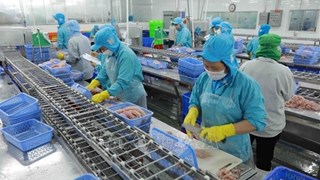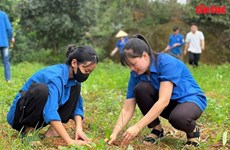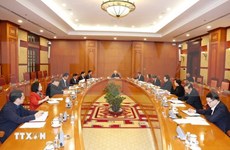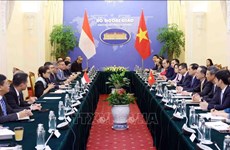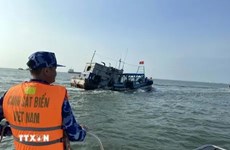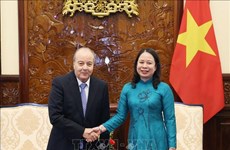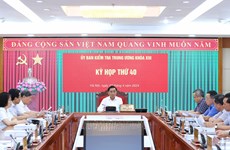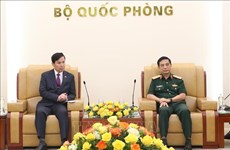Regional summits to create environment for sustainable development
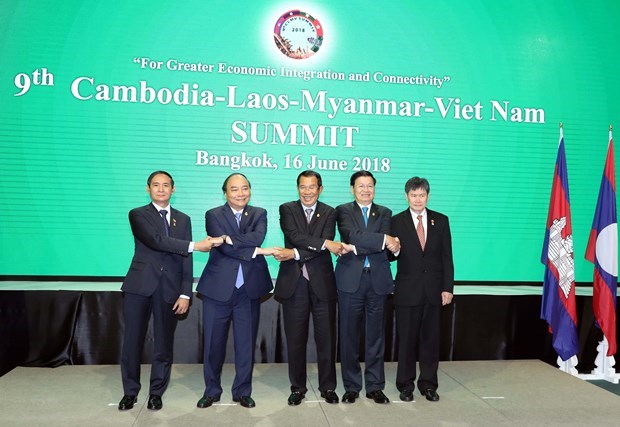 Myanmar President Win Myint, Prime Minister Nguyen Xuan Phuc, Cambodian PM Samdech Techo Hun Sen, Lao PM Thongloun Sisoulith and ASEAN Secretary General Lim Jock Hoi at CLMV-9 (Photo: VNA)
Myanmar President Win Myint, Prime Minister Nguyen Xuan Phuc, Cambodian PM Samdech Techo Hun Sen, Lao PM Thongloun Sisoulith and ASEAN Secretary General Lim Jock Hoi at CLMV-9 (Photo: VNA) Hanoi (VNA) - Prime Minister Nguyen Xuan Phuc’s
participation in several regional summits – ACMECS-9, CLMV-10 and CLV-11, to
be held virtually on December 9, reflects the importance that Vietnam attaches to
ACMECS, CLMV and CLV cooperation.
Vietnam also re-affirms its commitment to those cooperation frameworks,
which help create a favourable environment for sustainable development of each country
involved and the region as a whole.
ACMECS:
enhancing competitiveness, narrowing development gap
The Ayeyawady-Chao Phraya-Mekong Economic Cooperation
Strategy (ACMECS), also known as the Economic Cooperation Strategy (ECS), is an
economic cooperation framework that brings together Cambodia, Laos, Myanmar,
Thailand and Vietnam with an aim to enhance common economic cooperation and bilateral
coordination to tap the comparative advantages of regions and member states,
improve competitiveness and narrow development gap.
Set up in November 2003, the framework has so far covered
eight cooperation areas, including trade-investment, agriculture,
industry-energy, transport, tourism, human resources, health care and the environment
with eight working groups responsible for each area.
At the ACMECS-8 held in Bangkok, Thailand in 2018, leaders of
member countries agreed to restructure the eight cooperation areas and add some
new ones towards building a competitive economy via promoting multifaceted
connectivity. In the immediate future, priority is given to building roads
along the East-West and the Southern economic corridors, enhancing harmonisation
of trade and investment regulations and procedures, developing human resources
and technology, ensuring security as well as food and energy security, and
effectively using and managing water resources.
The 8th summit also adopted the Bangkok
Declaration and the ACMECS Master Plan for the 2019-2023 period.
On the occasion, Thailand also proposed the establishment of
the ACMECS Fund and the ACMECS Infrastructure Fund and Trust to raise capital
for ACMECS’s projects.
CLMV:
promoting integration in sub-Mekong region and ASEAN
At the ASEAN – Japan Summit held in Tokyo, Japan in December
2003, leaders of Cambodia, Laos, Myanmar and Vietnam consented to hold the
first CLMV Summit on the occasion of the 10th ASEAN Summit in Vientiane, Laos
in November 2004.
The CLMV cooperation mechanism covers trade-investment,
agriculture, industry-energy, transport, tourism and human resources
development.
The CLMV-1 adopted the Vientiane Declaration on enhancing
economic cooperation and integration within Mekong sub-regional, ASEAN and
regional cooperation frameworks, called on countries and international
organisations to boost support for the four countries to narrow development gap.
The CLMV-2 approved an Action Plan on partnering with
Thailand to consider the possibility of cooperation between CLMV and ACMECS to
avoid overlapping and improve cooperation efficiency.
The CLMV-3 saw agreement reached on combining CLMV and ACMECS
action plans.
The CLMV-4 agreed on orientations to fostering regional
collaboration in trade, investment, transportation, agriculture, industry,
energy, tourism, human resources development and encouragement of the
involvement of private sector and businesses in cooperation process.
The CLMV-5 passed a Joint Declaration on boosting cooperation
among four countries to narrow development gap with ASEAN member states.
The CLMV-6 agreed on major orientations, including improving
the efficiency of coordinating joint work; facilitating trade, investment and
tourism; increasing connectivity via fostering the development of economic
corridors and human resources.
The CLMV-7 vowed to strengthen trade and investment
collaboration among four countries and build new policies on facilitating trade
and the implementation of signed bilateral and multilateral agreements.
The CLMV-8 pledged to embark on cooperation in transport,
trade and investment facilitation, industry, tourism and human resources
development.
The CLMV-9 agreed to prioritise measures to narrow the development
gap within, especially in human resources development, high-tech agriculture,
tourism and creation of a favourable business environment.
Building a sustainable and prosperous CLV Development Triangle
The CLV Development Triangle was established in 1999 covering
10 provinces, namely Kon Tum, Gia Lai, Dak Lak and Dak Nong of Vietnam; Sekong,
Attapeu and Saravan of Laos and Stung Treng, Rattanak Kiri and Mondul Kiri of
Cambodia.
In 2009, the three countries agreed to add Vietnam’s Binh
Phuoc, Cambodia’s Kratie and Laos’ Champasak to the CLV development triangle.
Cooperation in the CLV framework focuses on security-external affairs,
transport, industry, agriculture, trade, investment, social affairs and
environment protection.
Apart from CLV Summits, the three countries also established a
Joint Coordination Committee on CLV Development Triangle Area with four
sub-committees on economy, socio-environment, local affairs, and
security-external affairs.
At the 10th CLV Summit on Development Triangle Area, leaders
of the three nations lauded achievements recorded in infrastructure, trade
facilitation, maintenance of regional peace and stability, and socio-economic
development.
They also adopted an Action Plan on linking the three
economies together till 2030.
The 10th CLV Summit, for the first time, saw the
participation of the Asian Development Bank, the World Bank and ASEAN as
development partners, thereby committing to promoting cooperation and
developing sustainable economies./.
